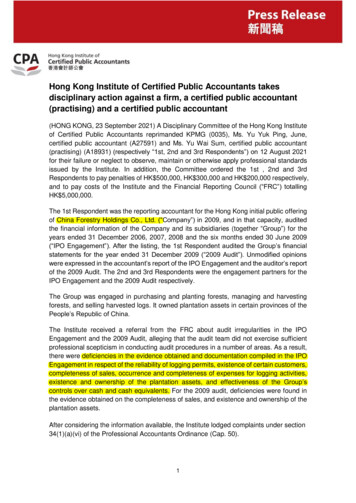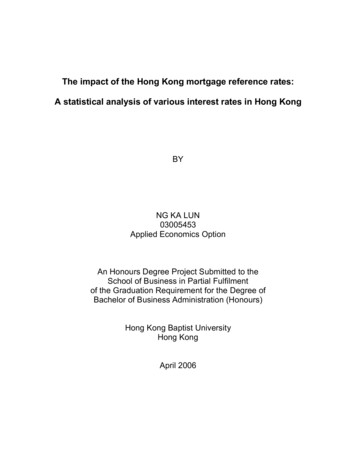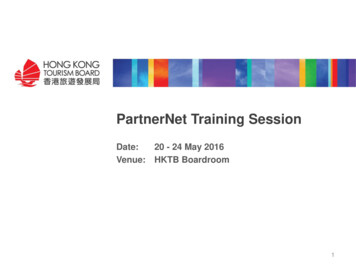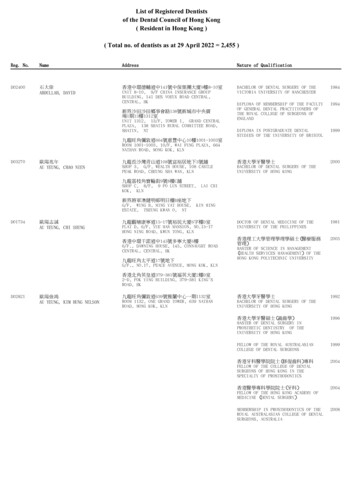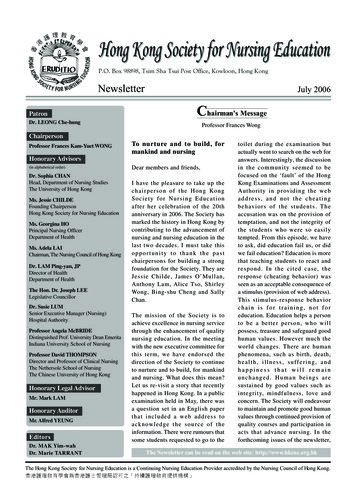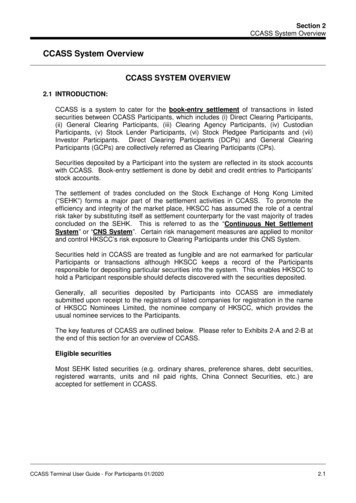
Transcription
Section 2CCASS System OverviewCCASS System OverviewCCASS SYSTEM OVERVIEW2.1 INTRODUCTION:CCASS is a system to cater for the book-entry settlement of transactions in listedsecurities between CCASS Participants, which includes (i) Direct Clearing Participants,(ii) General Clearing Participants, (iii) Clearing Agency Participants, (iv) CustodianParticipants, (v) Stock Lender Participants, (vi) Stock Pledgee Participants and (vii)Investor Participants. Direct Clearing Participants (DCPs) and General ClearingParticipants (GCPs) are collectively referred as Clearing Participants (CPs).Securities deposited by a Participant into the system are reflected in its stock accountswith CCASS. Book-entry settlement is done by debit and credit entries to Participants’stock accounts.The settlement of trades concluded on the Stock Exchange of Hong Kong Limited(“SEHK”) forms a major part of the settlement activities in CCASS. To promote theefficiency and integrity of the market place, HKSCC has assumed the role of a centralrisk taker by substituting itself as settlement counterparty for the vast majority of tradesconcluded on the SEHK. This is referred to as the “Continuous Net SettlementSystem” or “CNS System”. Certain risk management measures are applied to monitorand control HKSCC’s risk exposure to Clearing Participants under this CNS System.Securities held in CCASS are treated as fungible and are not earmarked for particularParticipants or transactions although HKSCC keeps a record of the Participantsresponsible for depositing particular securities into the system. This enables HKSCC tohold a Participant responsible should defects discovered with the securities deposited.Generally, all securities deposited by Participants into CCASS are immediatelysubmitted upon receipt to the registrars of listed companies for registration in the nameof HKSCC Nominees Limited, the nominee company of HKSCC, which provides theusual nominee services to the Participants.The key features of CCASS are outlined below. Please refer to Exhibits 2-A and 2-B atthe end of this section for an overview of CCASS.Eligible securitiesMost SEHK listed securities (e.g. ordinary shares, preference shares, debt securities,registered warrants, units and nil paid rights, China Connect Securities, etc.) areaccepted for settlement in CCASS.CCASS Terminal User Guide - For Participants 01/20202.1
Section 2CCASS System OverviewParticipantsThere are seven types of CCASS Participants: (i) Direct Clearing Participants, (ii) GeneralClearing Participants, (iii) Clearing Agency Participants, (iv) Custodian Participants, (v)Stock Lender Participants, (vi) Stock Pledgee Participants, and (vii) Investor Participants.(i) Direct Clearing Participants:All Exchange Participants of SEHK can be Direct Clearing Participants (DCPs) ofCCASS to clear and settle all their trades concluded on SEHK in eligible securities inCCASS. Before admission, Direct Clearing Participants are, amongst other conditions,required to subscribe for a non-interest bearing admission fee for HK 50,000 per tradingright in SEHK and have to make the requisite contributions to the Guarantee Fund (seelater).(ii) General Clearing Participants:General Clearing Participants (GCPs) must be either a licensed corporation licensed tocarry on Type 1 regulated activity or a registered institution registered to carry on Type 1regulated activity under the Securities and Futures Ordinance. A GCP must demonstrateits financial and operational capacity to establish and operate clearing business for othercorporations. Before admission, GCPs are, amongst other conditions, required to (i)subscribe for a non-interest bearing admission fee of the higher of HK 50,000 andHK 50,000 in respect of each trading right held by itself (if it is also an ExchangeParticipant of SEHK) and each of its underlying NCP, and (ii) make the requisitecontributions to the Guarantee Fund (see later).(iii) Clearing Agency Participants:Clearing Agency Participants (CAPs) are recognised bodies in the business ofoperating the central securities clearing and settlement system and/or central securitiesdepository system. Clearing Agency Participants are regulated in Hong Kong by theCommission or in an overseas jurisdiction by a governmental body or securitiesregulatory agency. A Clearing Agency Participant must demonstrate its financial andoperational capacity to establish and operate such a system, and the securities dealt within the system include eligible securities. Clearing Agency Participants are required tosubscribe for a non-interest bearing admission fee of HK 1,000,000.(iv) Custodian Participants:Only persons with an established custodian business in SEHK listed securities are to beadmitted as Custodian Participants of CCASS. Amongst other conditions, eachCustodian Participant is required to subscribe for a non-interest bearing admission fee ofHK 1,000,000 prior to admission.(v) Stock Lender Participants:Stock lenders are persons who lend SEHK listed securities to Clearing Participants whomay need to borrow shares to meet delivery obligations. At the initial stage of CCASS,stock lending within CCASS is restricted only to Clearing and Custodian Participants. Aperson other than a Clearing Participant or a Custodian Participant who wishes to join asa Stock Lender Participant will have to subscribe for a non-interest bearing admissionfee of HK 200,000.(vi) Stock Pledgee Participants:2.2CCASS Terminal User Guide - For Participants 01/2020
Section 2CCASS System OverviewOnly persons with an established business of lending money to Clearing Participantsagainst the security of SEHK listed securities are admitted as Stock PledgeeParticipants. Stock Pledgee Participants must have all requisite authorizations orlicences and are only allowed to effect stock pledging transactions in CCASS (inparticular, deposits of securities into CCASS by Stock Pledgee Participants will not beentertained). Stock Pledgee Participants are required to subscribe for a non-interestbearing admission fee of HK 200,000 prior to admission.(vii) Investor Participants:There are 3 types of CCASS Investor Participants: individual investor participants, jointindividual investor participants and corporate investor participants.Admission criteriaIn general, all Participants must be of good financial standing and must be fit and properpersons to be admitted as CCASS Participants. Each Participant must demonstrate it hasadequate resources to support its obligations under CCASS, e.g. the responsibility to makegood “defective” securities deposited into the system, and may be asked to provide financialsupport such as bank or parent guarantees or fidelity bonds etc. A Participant must alsocomply with the operational requirements of CCASS.All Participants must have the requisite status or authorizations under the relevant statutes.DCPs must be deemed to be a licensed corporation which is licensed to carry on Type 1regulated activity under the Securities and Futures Ordinance (as well as being anExchange Participant of SEHK). GCPs must be either a licensed corporation licensed tocarry on Type 1 regulated activity or a registered institution registered to carry on Type 1regulated activity under the Securities and Futures Ordinance. Clearing Agency Participantsmust be bodies recognised and regulated in Hong Kong or in an overseas jurisdiction by agovernmental body or securities regulatory agency or its equivalent. Custodian Participantsmust be authorized institutions under the Banking Ordinance or registered trusteecompanies under the Trustee Ordinance; or be deemed to be a licensed corporation whichis licensed to carry on Type 1 regulated activity under the Securities and Futures Ordinanceand which is not an Exchange Participant; or be the Monetary Authority under the ExchangeFund Ordinance (Chapter 66 of the laws of Hong Kong). In most cases, Stock LenderParticipants demonstrate to the satisfaction of HKSCC that it either has an established stocklending business in Hong Kong in securities listed on the Exchange or that it has thefinancial and operational capacity to establish and operate a stock lending business in HongKong and has available and sufficient quantity of securities listed on the Exchange forlending and demonstrate to the satisfaction of HKSCC that it has an established business inHong Kong of lending money against the security of securities listed on the Exchange orotherwise demonstrate that it has the financial and operational capacity to establish andoperate a business in Hong Kong of lending money against the security of securities listedon the Exchange. Stock Pledgee Participants must be authorized institutions under theBanking Ordinance or licensed money lenders under the Money Lenders Ordinance anddemonstrate to the satisfaction of HKSCC that it has an established business in Hong Kongof lending money against the security of securities listed on the Exchange or otherwisedemonstrate that it has the financial and operational capacity to establish and operate abusiness in Hong Kong of lending money against the security of securities listed on theExchange. Investor Participants are required to sign the Terms and Conditions.CCASS Terminal User Guide - For Participants 01/20202.3
Section 2CCASS System OverviewIn addition, each Participant must enter into an agreement with HKSCC undertaking tocomply with the rules and regulations of CCASS from time to time in force, which includesaccounting and reporting requirements.Electronic linkageAll Participants must be electronically linked with CCASS. Details of the technical interfacerequirements are set out in Section 7.1.Immobilization/book-entry settlementCCASS operates on a system of immobilization - certificates with signed transfer formsattached are deposited by Participants with HKSCC and are reflected in their CCASS stockaccounts to facilitate book-entry settlement (by debit and credit entries to the relevant stockaccounts).HKSCC treats Participants as having full control over the securities recorded in their CCASSstock accounts. For the purposes of CCASS, Participants are regarded as dealing asprincipals with each other for transactions settled in CCASS, and not as agents for theirclients.Stock accountsThere are five types of stock accounts in CCASS: (i) Stock Clearing Accounts, (ii) StockSegregated Accounts, (iii) Stock Lending Accounts ,(iv) Stock Collateral ControlAccounts and (v) TSF Accounts. Each Participant has one Stock Clearing Account(Account Number 1), and up to 15 Stock Segregated Accounts without statements (AccountNumber 2 to 16). Stock Segregated Accounts with Statement Service are also available toClearing Participants and Custodian Participants starting from Account Number 21 onwards,account numbers starting from the range 80100000 to 89999999 are reserved for internaluse (except for Custodian Participants and GCPs who are not Exchange Participants canopen Special Segregated Accounts with Account Number 80000000 to 80099999, forholding China Connect Securities to facilitate Pre-trade Checking). Clearing Participantshave an additional Stock Collateral Control Account (Account Number 20). TSF CCASSParticipants will be assigned with two designated TSF Accounts (Account Number 17 and18).Stock Clearing Accounts (A/C 1) are used primarily to settle transactions in CCASS.Securities, if available and subject to the money settlement method elected, are debitedfrom the Stock Clearing Account of the delivering Participant for transactions settled underthe multiple batch settlement runs (see later). If the delivering Participant chooses toeffect delivery by a Delivery Instruction (DI), he may decide to debit from any of his stockaccounts (except Stock Segregated Accounts with Statement Service which requireaffirmation), subject to availability of securities.In either of the above cases, acorresponding quantity of securities will be credited to the Stock Clearing Account of thereceiving Participant.TSF Accounts (A/C 17 and 18) are used by Participants who registered as TSF CCASSParticipants to clear, settle and hold TSF Stocks. TSF Principal Account (A/C 18) is themain stock account where to facilitate the credit and debit of TSF Stocks for the purposes ofearmarking and/or de-earmarking of TSF Stocks; whereas TSF Segregated Account (A/C17) is an additional stock account for Participant to hold its earmarked TSF Stocks.2.4CCASS Terminal User Guide - For Participants 01/2020
Section 2CCASS System OverviewStock Lending Accounts (A/C 19) are used by Participants who apply as lenders for stocklending purpose. All securities credited to the Stock Lending Accounts will be used byHKSCC for lending purpose in accordance with CCASS rules.Stock Collateral Control Accounts (A/C 20) are used by Clearing Participants to hold theirCCASS stocks as collateral securities and the balance of these collateral securities arereflected in the collateral account under the Common Collateral Management System(CCMS).Stock Segregated Accounts are provided to facilitate Participants’ internal record keepingand can be used in whatever manner they consider appropriate. Except for the firstSegregated Account (A/C 2), HKSCC does not have access to participants’ StockSegregated Accounts except for the recovery of defective securities in accordance withCCASS rules. Securities in Stock Segregated Accounts are only used at the specificinstructions of the Participants.GCPs who perform clearing and settlement of ChinaConnect Securities for China Connect Exchange Participants are required to transfer thesettled China Connect Securities to each NCP’s designated Stock Segregated Accountsbefore day end. Custodian Participants and GCPs who are not Exchange Participants canopen Special Segregated Accounts for holding China Connect Securities of their investors.Stock Account 2 is named the Entitlement Account which is used by HKSCC for distributingbenefit entitlements to Participants and for effecting adjustments in benefit entitlements.Participants can choose to assign names for the remaining segregated accounts (i.e. StockSegregated Accounts without statements (A/C 03 to 16) and Stock Segregated Accountswith statements (A/C 21 onwards)) at their will.Participants who wish to open Stock Segregated Accounts without statement should submitwritten request to HKSCC. Stock Segregated Accounts with Statement Service (“SSA withStatement Service”) are maintained by Clearing and Custodian Participants. Person(s)named and/or maintained by a Clearing / Custodian Participant in respect of a SSA withStatement Service (“SSA Statement Recipient”) will receive statements from CCASS.Besides, SSA Statement Recipients are able to enquire stock movements and accountbalances, enquire, give and change voting instructions, enquire and affirm StockSegregated Account Transfer Instructions (STIs) via the CCASS Internet System andCCASS Phone System. Statements in electronic form will also be available on the CCASSInternet System. SSA Statement Recipients are also able to subscribe to receive alertmessages relating stock movement, STIs and voting information of the accounts via ShortMessage Service (SMS) and/or email. When an SSA with Statement Service is added ordeleted from CCASS and there is any change in the personal details and/or designatedbank account information of the accounts, a notification letter will be sent to thecorresponding SSA Statement Recipients, and alert message will be issued via SMS and/oremail, if applicable.Special Segregated Accounts (SPSAs) are maintained by Custodian Participants and GCPswho are not Exchange Particpants. Upon the successful creation of a SPSA in CCASS, anInvestor ID will be generated and the Custodian Participants or GCPs should submit theInvestor ID together with other relevant detail in written format to HKSCC, before the ChinaConnect Securities held at the SPSA are eligible to be sold via the China Stock ConnectSystem. Statement Service, SMS / email alert messages, corporate communicationsservices, voting instructions input by investors, CCASS Phone System and CCASS InternetSystem are not available to SPSA.A Participant is able to move shares between stock accounts 1 to 16 and 19 by inputting anAccount Transfer Instruction (“ATI”), which is effected immediately upon input. Mass ATIis also available for participants to move securities from their Stock Clearing Account (A/C 1)CCASS Terminal User Guide - For Participants 01/20202.5
Section 2CCASS System Overviewto a designated account (A/C 2 to 16, 19), which is effected at day end processing.Earmarked TSF shares only can be transferred between the two TSF Accounts (i.e. A/C 17and 18) via ATI. Transferring shares into TSF Accounts via ATI will only be allowed if thereis outstanding TSF earmarking obligation. Stock Collateral Control Accounts (A/C 20) is thestock account where the collateral securities are held and the shareholdings are reflectedunder the Common Collateral Management System (CCMS). The ATI function will not beapplicable to A/C 20 and Participants should use CCMS functions to effect stockmovements for this account.A Participant is able to move securities from and/or to an SSA with Statement Service (A/C21 onwards) or a SPSA (A/C 800XXXXX) by inputting a Stock Segregated AccountTransfer Instruction (“STI”). There are two types of STI:(i)Without Affirmation: STI input (and authorised, if required) by a Participant wherethe STI affirmation requirement of the delivering SSA withStatement Service is not being selected. It will be effectedimmediately upon input.(ii)With Affirmation:STI input (and authorised, if required) by a Participant wherethe STI affirmation requirement of the delivering SSA withStatement Service is being selected. Such STI requires theSSA Statement Recipient to affirm before the transfer is beingeffected by CCASS. Not applicable to STI involving SPSA.Mass STI is also available for Participants to transfer securities from their Stock ClearingAccount (A/C 1) to an SSA with Statement Service or a SPSA and it is effected at day endprocessing.STI can be settled on a “Free of Payment” (FOP) or “Delivery versus Payment” (DVP) basis.STI between two SSAs with Statement Service or involving SPSA should be settled on a“Free of Payment” (FOP).DVP STI is only available to the transferring of EligibleSecurities out from an SSA with Statement Service (i.e. with payment to be credited to theSSA Statement Recipient). Upon the completion of transfer of a DVP STI, HKSCC will issueEPI as normal to instruct the Designated Bank of the Participant to effect payment bycrediting the payment amount to the Designated Bank Account of the SSA StatementRecipient.2.6CCASS Terminal User Guide - For Participants 01/2020
Section 2CCASS System Overview2.2 CLEARING AND SETTLEMENT OPERATIONS:A. Trades on SEHKAn Exchange Participant of SEHK can either clear and settle trades itself as a DirectClearing Participant, or appoint a General Clearing Participant to clear and settle tradeson its behalf.Details of trades are forwarded by SEHK to HKSCC on a real-time basis. There is noneed for Clearing Participants to input such trade details into CCASS.Substitution:In case a broker of a trade is not a Direct Clearing Participant, the GCP of the broker willbe substituted as the settlement counterparty of the trade for clearing and settlement inCCASS.All trades on SEHK in eligible securities are settled in CCASS under one of the followingtwo different systems:(i)the “CNS System”: where the original transaction is discharged by novation andreplaced by contracts where HKSCC becomes the settlement counterparty andsettlement is effected between HKSCC and Clearing Participants; and(ii) the “Isolated Trades System”: where settlement is effected directly between theClearing Participants.The settlement period for SEHK Trades (except China Connect Securities Trades) is T 2(i.e. the second settlement day following trade day). China Connect Securities Tradeswill be settled in CCASS via CNS System only, securities and money settlement forChina Connect Securities Trades are on T and T 1 day respectively.CNS System:In general, unless the two trading counterparty brokers elect to have a trade settled inCCASS under the Isolated Trades System or unless they are isolated from the CNSSystem by HKSCC, all trades in eligible securities concluded on SEHK are settled inCCASS under the CNS System.Under the CNS System, each trade executed on SEHK is replaced by two contracts, onebetween the delivering Clearing Participant and HKSCC as the receiving counterparty,and the other between the receiving Clearing Participant and HKSCC as the deliveringcounterparty.The obligations arising under these new contracts (“market contracts”) are netted, i.e.offset against each other so that a Clearing Participant has one net receiving (long) ordelivering (short) stock position with HKSCC as settlement counterparty for trades in aparticular security on a trade day.This netting process operates on a continuous basis, in that a net overdue stockposition of a Clearing Participant on one day is brought forward and netted against anyopposite position due for settlement in that stock the following day.CCASS Terminal User Guide - For Participants 01/20202.7
Section 2CCASS System OverviewHong Kong MarketHKSCC issues two sets of Provisional Clearing Statement to Clearing Participants shortlyafter 5:00 p.m. and 8:00 p.m. respectively on T day to record the details of the marketcontracts. These netted market contracts enjoy HKSCC’s “guarantee” under the CNSSystem, subject to trade amendments, any “late” Exchange Trades and trades notrecognized by the Exchange. In addition, to facilitate GCPs to handle and monitor thetrades of their underlying NCPs, ten sets of Intra-day Trade File containing details oftrades cleared by respective GCP at individual NCP level will be generated shortly after9:45 a.m., 10:15 a.m., 10:45 a.m., 11:30 a.m., 12:00 noon, 1:15 p.m., 2:00 p.m., 2:45p.m., 3:30 p.m. and 4:15 p.m. on each trading day.Trade amendments to Exchange Trades agreed by the original trading ExchangeParticipants are accepted on T 1 up to 15 minutes after the commencement of themorning trading session, subject to the approval of HKSCC and SEHK. On T 1, not longafter the close of morning trading session, HKSCC will issue Final Clearing Statement toClearing Participants confirming the final settlement positions, including the amendedtrades which are novated, netted and guaranteed for settlement under the CNS System.China Connect MarketFor settlement of China Connect Securities Trades, HKSCC issues a Final ClearingStatement for Shanghai and Shenzhen markets separately to the China ConnectClearing Participants shortly after 4:00 p.m. on T day to record the details of the ChinaConnect Securities market contracts. These netted market contracts enjoy HKSCC’s“guarantee” under the CNS System. In addition, to facilitate GCPs to handle and monitorthe China Connect Securities Trades of their underlying NCPs, eight sets of Intra-dayTrade File containing details of China Connect Securities Trades cleared by respectiveGCP at individual NCP level will be generated shortly after 9:45 a.m., 10:15 a.m., 10:45a.m., 11:45 a.m., 1:15 p.m., 2:00 p.m. and 2:30 p.m. and 3:30 p.m. on each trading dayfor Shanghai and Shenzhen markets separately. Trade amendment is not applicable toChina Connect Securities Trades.As settlement counterparty, HKSCC allocates securities received by it from ClearingParticipants with net delivering (short) positions to Clearing Participants with net receiving(long) positions in accordance with the following allocation algorithm:-age (oldest)position price (highest)position size (smallest)randomIsolated Trades System:Two trading counterparty Exchange Participants may opt to have a trade settled underthe Isolated Trades System and not the CNS System by election at the time of trade.Trade isolation may also be initiated by HKSCC for risk management purposes.Settlement in CCASS is then effected directly between the two relevant ClearingParticipants on a trade-for-trade basis. HKSCC does not become the settlementcounterparty.Like the CNS system, trade information for isolated trades is also summarized in theProvisional Clearing Statements (on T day), Final Clearing Statement (on T 1 day aftertrade amendments) and Intra-day Trade File (on T day and for GCPs only).2.8CCASS Terminal User Guide - For Participants 01/2020
Section 2CCASS System OverviewB. Other transactionsTSF FX Transactions and Stock Release Requests (Hong Kong Market only):Clearing Participants can clear and settle TSF FX Transactions and perform StockRelease Requests in CCASS only if they are registered as the TSF CCASS Participants.Custodian Participants, upon registration as TSF CCASS Participants, can also hold TSFshares and perform Stock Release Requests in CCASS.On each trade day, CCASS issues a TSF Confirmation Report to TSF CCASSParticipants after 6:00 p.m. on T and T 1 days, recording those TSF FX Transactionsand Stock Release Requests executed on current Business Day and to be settled on thefollowing Business Day.Same as Exchange Trades, to facilitate the CNS settlement, TSF CCASS Participantsshould settle their TSF FX Transactions and earmarking/de-earmarking TSF shares onthe settlement day, i.e. T 2.If a TSF CCASS Participant wish to release its earmarked TSF shares without selling theTSF shares, it should maintain a Stock Release Request in CCASS. Upon submissionand authorisation, the TSF shares will be released and transferred from its TSF Acocunts(17 ot 18) to its designated reciving account. In return the TSF CCASS Participantshould replenish RMB to TSF in exchange of the equalivent amount of HKD on thepayment day, i.e. two settlement days after the Request date.8:00 a.m. on the settlement/payment day, i.e. T 2, based on the TSF FX Transactionsand/or Stock Release Requests executed by TSF CCASS Participants, CCASS willgenerate TSF Payment Instructions for TSF CCASS Participants to settle by 3:00 p.m. onthat day. After receipt of the TSF payments, CCASS will credit the exchanged amount(either in RMB or HKD) to the Participants’ money ledger account(s) for moneysettlement via DDI / DCI.Table 2.0 lists the CCASS functions and reports related to TSF FX Transactions / StockRelease Requests.TABLE 2.0: Functions and reports related to TSF FX Transactions / Stock ReleaseRequestsSections inCCASS Functions / ReportsthisUser onReports Stock Release Request MaintenanceSection 8.1.13 Enquire TSF Payment InstructionSection 9.1.9 TSF FX Transaction/Stk Rlse Activity / StatusReport TSF Confirmation ReportSection 4.3Settlement Instructions:For transactions other than SEHK Trades, each of the two Participants concerned oneach occasion has to input a Settlement Instruction (“SI”) into CCASS containing theCCASS Terminal User Guide - For Participants 01/20202.9
Section 2CCASS System Overviewtransaction details etc. SI transactions can include broker-custodian transactions, newstock borrowing/lending, return/recall of borrowed stock, stock pledging transactions andportfolio movements.The INPUT SI function is used to input SI details into CCASS. Each pair of SIs input intothe system are matched by CCASS on a batch basis. After successful matching, asettlement position is created for the transaction and it is ready for settlement. AParticipant may opt to apply an on-hold mechanism for holding settlement of a SI aftermatching. Settlement of such SI will not be effected until the matched on-hold SI hasbeen released by the initiating party(ies). This type of SI would have a “Matched Onhold” status after successful matching.If the input value or market value of the stock of an SI exceeds the input transaction limitof the authorised user, the SI created will have a “Pending” status. Pending SIs arerequired to be authorised through AUTHORISE PENDING SI function before it can bechanged to “Unmatched” status.Before matching, an SI can be changed or deleted through the terminal. The CHANGEMATCHED/SETTLED SI function is provided to:(1) change the following non-matching fields of a “Matched” SI or “Matched On-hold” SI: Stock Settlement Account Client Name Internal Transaction Reference SI Linkage Reference Remarks(2) release the “SI link on-hold shares” by deleting the “SI Linkage Reference” of a“Settled” receiving SI.The REVOKE MATCHED SI function is provided to cancel matched but unsettled SIsand matched on-hold SIs.Any SIs unmatched for fourteen calendar days after input, and any SI transactions(matched or matched on-hold SIs) unsettled for fourteen calendar days after thestipulated settlement date will be purged i.e. excluded from the system. Also, pendingSIs that remain unauthorised for fourteen calendar days, revoked SIs and settled SIs willalso be purged from the system.To assist Participants to reduce the follow-up work on unmatched SI, the ENQUIREUNMATCHED SETTLEMENT INSTRUCTION REASON function (“LSUE”) and theUnmatched SI Report will provide Participant’s SI details to those counterparties of whomthe Participant has agreed to disclose such information. In this regard, Participants areprovided with a set of new online functions relating to “Hide Unmatched SI ContentCounterparty List” maintenance for selecting whether to hide the unmatched SI details totheir counterparty at counterparty level. CCASS will display the unmatched SI details inLSUE function and the Unmatched SI Report according to the decision of the Participant: If Participants choose to hide unmatched field contents of their SI to theircounterparties, only the SI input number of the Participants’ SI will be shown to thecounterparties in LSUE function. For Unmatched SI Report, the SI input number ofParticipants’ SI and Participant ID will be shown. If Participants choose not to hide the
The settlement of trades concluded on the Stock Exchange of Hong Kong Limited ("SEHK") forms a major part of the settlement activities in CCASS. To promote the . Certain risk management measures are applied to monitor . CCASS Terminal User Guide - 5For Participants 01/2020 2. Stock Lending Accounts

